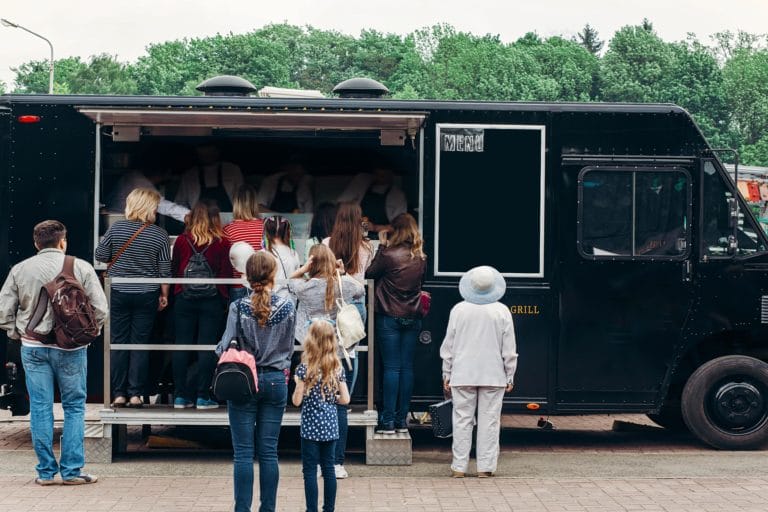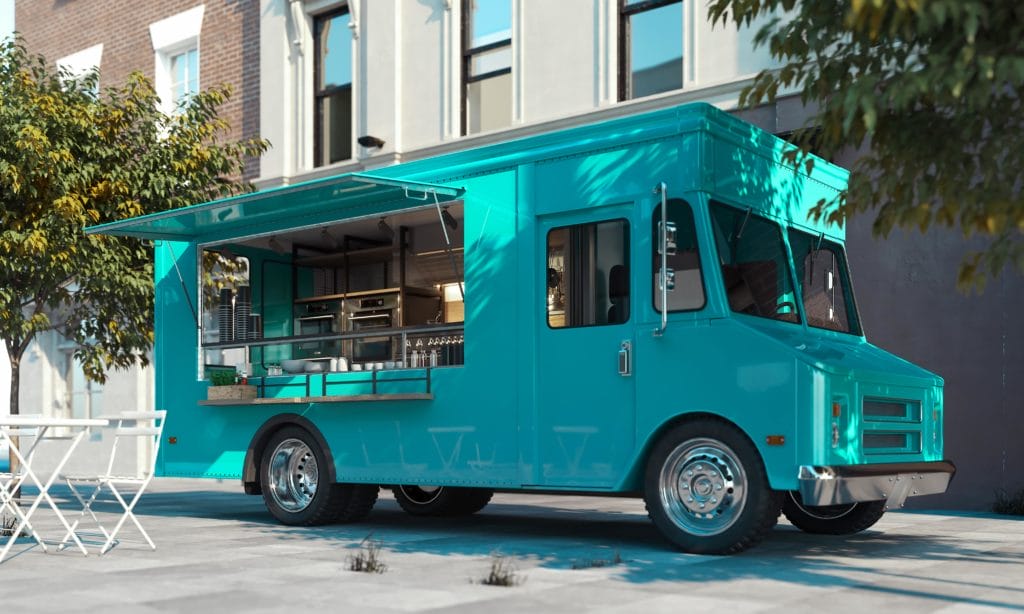Last Updated: July 15, 2024
You have the skills, some killer recipes, and a food truck that’s ready to travel.
But now what?
Having a successful food truck business means knowing how to market it. After all, what good is an awesome menu without any customers to try it?
Don’t worry! In a world that’s more connected than ever, food truck marketing success is accessible to anybody with a computer and a little entrepreneurial spirit. We’re here to help with ten tips for developing a food truck marketing plan that will have customers flocking to every festival, fair, and pop-up you attend.
How to Market a Food Truck
As of 2022, there were an estimated 35,000 to 40,000 food trucks operating in the United States, with those numbers only expected to grow.
There’s no reason you shouldn’t be one of the thousands to take your own bite of success — put these ideas into action and you’ll be on the road to more sales in short order:
- Connect on social media
- Build a web presence
- Brush up on SEO basics
- Use email
- Create attention-grabbing ads
- Craft an irresistible menu
- Make your food truck stand out
- Send trust signals
- Build rapport in the community
- Partner with other businesses
Your Food Truck Marketing Strategy Plan
From cultivating your online presence to building relationships in the community, you can develop a winning food truck marketing strategy in a variety of ways.

1.) Promote Your Food Truck on Social Media
As of April 2024, there were over 5.07 billion social media user identities.
With numbers like that, it’s easy to see why social media is one of the best ways to market your food truck business.
The best part? It’s free!
All of the major social media sites can be great platforms for marketing your business. However, they each function differently, so it’s important to understand what they do and who is using them.
Facebook is one of the “OG” social media platforms and a great tool for your business. The top demographic of Facebook is adults aged 25 to 35 — so millennials.
With Facebook, you can:
- Join food truck groups and network with peers
- Join and engage in community groups
- Post your location or upcoming events
- Ask satisfied customers for reviews
On Instagram (IG), you can post eye-catching food or beverage content to your story and feed, run ads, and link your website. It allows customers to contact you and really get to know your brand, making IG an excellent platform to promote your food business.
The demographic of Instagram is between 18 and 24 years old, so a bit younger than most Facebook users. However, the overlap is close, so you should have both Facebook and Instagram. You can even link them so that posts automatically go to both accounts.
TikTok
TikTok allows you to showcase your food, sneak peeks behind the scenes, and the events you attend in short-form videos. The typical user age of TikTok is 18 to 24 years old.
You could post a timelapse of you making your delicious donut kabobs, share your version of a trending video, showcase your menu, or even spotlight your employees. These are all videos that can support your brand and show users just who you are.
The typical Pinterest user is between 35 and 44 years of age. If your website features a blog, then you will want to post it on Pinterest. If you blog about the next festival you’ll be attending, the best way to eat a taco, or where you source your ingredients, post it to Pinterest.

Once you understand which platforms apply to your brand, you can develop your strategy. Ask yourself these questions:
- Who is my audience?
- Which platforms are best to reach these customers?
- What elements of my business do I want to share?
- How can I adapt my content for each of the platforms I’m using?
For example, let’s say you want to market your taco food truck on social media.
Maybe you learn that the average age in your area is 20 to 45 years old. You might also learn from polling data that locals love to see pictures of your food and behind-the-scenes details.
Based on this data, you want to focus your marketing efforts on Facebook, Instagram, and TikTok, producing overlapping but unique content for each:
- Snap a few pictures of your newest taco creations and post them on Facebook with a location tag and how long you’ll be open.
- Post the same images on Instagram with a caption calling out your new dishes and a few strategic food truck hashtags.
- For TikTok, create a short video of you preparing the food from prep to final product, demonstrating the time and care that goes into every taco.
In the time it takes you to prepare a couple of orders, you’ll have quality, targeted content for your three main social media accounts.
2.) Build a Web Presence
93% of consumers search for local businesses online.
A website is essential for your food truck marketing plan. Giving existing and potential customers a place to learn about your business, contact you, and see where they can find your truck is a great resource.
Create a Website
Building a site is inexpensive and fairly easy thanks to the many website-building tools available, like:
- Square Online: Beginner-friendly with ready-made templates and features for restaurants, including online ordering, mobile point of sale capabilities, and Square payments integration
- Wix: Most robust features, integrations, and native capabilities — as such, not the easiest for beginners
- GloriaFood: Dedicated food business website builder, online ordering and website starting free, and easiest for total beginners
Letting customers know who you are, where to find you, and how to book your services is the most important function of your website.
Get a Domain
Once you have the site built, you’ll need to secure your domain. You can buy a domain name for $10–$20 a year through one of several registrar options or get one when creating your site on apps like Wix.
Here are a few helpful guidelines for choosing the best domain name:
- Make it the same as your business name
- Keep it short
- Avoid punctuation, numbers, and back-to-back letters
Register Your Business Profile
Finally, once your website is built and your domain is secured, claim your free Google Business Profile. This adds your website and location (optional) to Google Search and Maps, creating a quick-view breakdown of your contact information, reviews, and photos/videos.
In addition to boosting visibility when customers search for food trucks in the area, this provides insights into how people search to find you and how those searches convert to customers.

3.) Brush Up on SEO Basics
While your food truck business requires face-to-face interaction, customers are more likely to find you if your website and business profile rank in searches. Here are a few search engine optimization (SEO) basics to enhance your online food truck marketing strategies — no SEO expertise required!
Use Keywords
Keywords are the relevant words, terms, and phrases customers use to search for your business. When you include keywords in your content, search engines are more likely to list your site when a user searches for those terms.
Figuring out which keywords to use on your website is pretty simple. In essence, it’s the words or phrases people would search for online when looking for a business like yours.
For example, if you operate a food truck in Dallas, Texas, you could start with these keywords:
- Dallas food truck
- Dallas Texas food truck
- Food trucks in Dallas Texas
- Taco trucks in Dallas Texas
Keep It Mobile-Friendly
In a world where 97% of Americans own cell phones, a mobile-friendly website is a must. After all, your food truck is a mobile business. Odds are that your clients will be on the go when they want to drop in for a bite to eat.
In terms of SEO, Google does mobile-first indexing, meaning that sites optimized for mobile rank higher than those designed exclusively for desktop viewing.
Some easy ways to make your site mobile-friendly include:
- Keeping text short and breaking up long paragraphs
- Optimizing images and videos for web use
- Avoiding popups
- Breaking up text areas with elements like subheadings and bullet lists
Keep an Eye on Reviews
Around 93% of consumers say that online reviews impact their buying decisions. Encouraging your customers to leave reviews and monitoring them closely can have a big impact on your business. Even negative reviews provide an opportunity for you to engage with customers and show that you care.
Reviews are also important for SEO. Google’s algorithm considers customer reviews when ranking search results. This includes the star rating as well as the overall quantity, written length, frequency, and several other factors.
Encourage your satisfied customers to leave you a review and monitor them on a regular basis. If you receive complaints or negative reviews, take the time to respond and make it right if you can.
4.) Reach Out Via Email
Email is a great way to market your business, particularly when you operate a food truck. When an existing or potential customer shares their email address with you, it’s an opportunity to connect with them and share information.
You can build a list of email addresses in a few different ways:
- Add a form to your website prompting visitors to share their email addresses so they can receive updates.
- Use social media to direct visitors to your site’s contact form to reach a wider audience.
- Create a unique QR code that directs people to your site. Post your code on your truck, your business card, and anywhere else you advertise.
In a world filled with spam and scam emails, customers are wary of sharing their email addresses. Give them a nudge by offering an incentive when they sign up, like a free side or drink.
Once you have an email list, there are a few ways you can use it for marketing your food truck.
Newsletter
Use your newsletter to communicate the most important information that your customers will care about, such as:
- Your event schedule
- Menu updates and additions
- Behind-the-scenes info
- Images from your latest events
- Contact information for booking
It’s best to keep your newsletter easy to read, scannable, and packed with information your customers want to see. Avoid fluff or flashy graphics that can make emails difficult to load.
Location Updates
Use your mailing list to let people know where you are and where you’ll be. With a food truck business, you’re always on the move. A quick email update keeps customers informed so they know where to find you.
You can even market your location mailing list as an exclusive perk for loyal customers, giving them the advantage of being “in the know” about your next stop. The only way to avoid FOMO is to sign up!
5.) Create Attention-Grabbing Food Truck Ads
Since your food truck most likely operates locally, you can take advantage of many free or cheap advertising opportunities in your community. Here are some food truck advertising ideas to help you get started:
- Social media ads: Facebook and Instagram have powerful ad platforms that enable you to reach the exact audience you’re looking to attract.
- Local mailers and newspapers: Many areas have weekly or monthly mailers for residents. Check to see if you can run a food truck advertisement to drum up business.
- Flyers: Print some flyers and keep them on hand whenever you’re out and about. Pin them to bulletin boards and ask local businesses if you can leave a stack for customers.
The best local advertising is a combination of digital, print, and word-of-mouth so that you’re reaching as many people as possible.

6.) Craft an Irresistible Menu
Foodies are the target market for food trucks. If you want to hook folks who know good grub, you need to design an amazing menu.
For starters, it’s always best to master a handful of excellent offerings rather than overstuffing your menu with options. Most food trucks stick with 6 to 12 menu items to save money and create a curated feel.
This also ties back to your brand identity — pinpoint what your business is all about and do it well.
Once you’ve chosen which items to feature on your menu, you need to make it look as good as it tastes. Use descriptive language that shows the customer what they’re getting.
For example, which of these would you be more likely to order?
Grilled Cheese Sandwich – $8.00
Or…
Melty Swiss and gruyere cheese between two slices of lightly grilled brioche bread, topped with a smear of truffle butter – $7.95
In this example, $8 may seem like a lot to pay for a regular white bread and American cheese sandwich, but the descriptive menu listing shows the customer they’re getting what they pay for. Plus, ending the price in “.95” instead of a rounded dollar creates the appearance of a greater value.
7.) Design a Food Truck That Pops
When you’re parked in a long row of food trucks, it can be tough to stand out. The best way to make sure you don’t get lost in the crowd is to decorate the exterior with an eye-catching design.
This can be as simple as choosing an amazing color scheme for your food truck. Bold hues stand out more, but you may also set yourself apart by choosing a pastel palette. It all depends on your brand and where you operate.
If it’s within your budget, consider a colorful graphic design that showcases your logo or the kind of food you specialize in. You can even invest in a custom wrap for your food truck to give it a more professional touch.
Lighting can also do wonders to help with marketing your food truck. An LED sign is an attention-grabbing addition that adds polish to your exterior. If you often operate at night, consider investing in some undercarriage lighting that really pops when the sun goes down.
8.) Show Customers You’re Trustworthy
Providing excellent service and selling delicious food is the first step in showing customers they can rely on your business, but that involves convincing them to try your product first.
Trust signals are badges or seals you can display on your website, social media, and physical marketing. These can go a long way in showing potential customers you are a responsible business owner.
For example, you can display your FLIP insurance badge on your marketing materials to increase your brand’s credibility and trust in your products. Just like a recognizable credit card reading machine’s logo helps consumers trust putting their card in it, displaying a badge verifying that you have food truck insurance lets them know you care about protecting your customers, business, and partners.

9.) Cultivate Relationships in Your Community
To have a successful food business, you need to be out and about in the area you serve.
Most of your food truck marketing strategy comes down to visibility, so the first step is identifying food truck events where you’ll be a good fit. This can include:
- Fairs
- Festivals
- Sporting events
- Concerts
- Community events
Try getting into as many local events as possible to build up your reputation.
It’s just as important to get involved in your community beyond money-making opportunities. Join your Chamber of Commerce and networking groups to build connections with other local businesses and organizations.
Check out your city’s event calendar for community events where you can volunteer and connect. If you’re in a position to do so, donate food, supplies, or special deals to schools and charity organizations.
Not only is this an opportunity to give back to your community, but you can also gain some free advertising in the process!
10.) Partner Up With Local Businesses
Partnering with other local businesses can double your potential for finding events and building your customer base. Start by attending networking events to meet other business owners who may be interested in collaboration.
For example, the property owner of a local office building may want to bring in a few food trucks each week for lunchtime. Or, perhaps a little league team needs a few food vendors for an all-day tournament.
These partnerships create revenue for your business and provide prime food truck marketing opportunities by giving you visibility in your community.

Best Tools for Measuring Marketing Success
There are many ways to measure the success of your food truck marketing plan. Check out these important metrics and the free or inexpensive tools to help you track them.
- Social media engagement: Buffer tracks impressions, engagement, follower growth, and other essential data for your social media accounts.
- Website traffic and CTR: Google Analytics provides data for site traffic, bounce rates, conversions, and more. You can also use a free trial on Semrush for keyword analytics and rankings.
- Email leads: Manage your email leads and track their success with HubSpot.
- Sales: Since your food sales are in-person, a Point of Sale (POS) is one of the best ways to track your sales and how they sync up with inventory. Square and Toast are both strong options for food trucks.
Brand awareness: Several of the above tools track elements of brand awareness. You can also set a Google Alert to see what people say about your business online.
Make Your Marketing Count
Whether you’ve been in the biz for years or you’re just starting, it’s never too late to up your food truck marketing game.
Just like mastering your secret recipe, effective food truck promotion takes time, effort, and dedication. But, it’s all worth it when you see the final result!

By Lindsey Fliger
Ohio-based copywriter Lindsey Fliger leverages her experience as a lifelong foodie, dedicated home chef, and very decent baker. She holds a bachelor’s in English from Kent State University and a master’s in English Literature from The University of Akron. Before Veracity, she wrote about everything from kitchen tools to decadent wines at Zulily.


